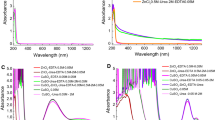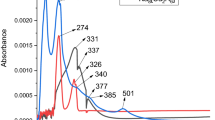Abstract
The antibacterial mechanisms of Cu(phen)2Cl2·6H2O, [Cu(phen)(Gly)(H2O)]Cl·3H2O, [Cu(phen)(l-Ser)(H2O)Cl] (1,10-phenanthroline (phen)) on Escherichia coli were investigated. In the inductively coupled plasma atomic emission spectroscopy experiments, it showed that lipophilic phen ligand can cause elevation of intracellular copper, but intracellular copper is not the decisive factor. The UV–vis and gel electrophoresis experiments reveal that the DNA binding and cleavage activity are decisive factors for the antibacterial action of these compounds. It is revealed by the cyclic voltammetry experiments that the redox potential was bound to the cleave activity.




Similar content being viewed by others
References
Iakovidis I, Delimaris I, Piperakis SM (2011) Copper and its complexes in medicine: a biochemical approach. Mol Biol Int. doi:10.4061/2011/594529
D'Aurora V, Stern AM, Sigman DS (1977) Inhibition of E. coli DNA polymerase I by 1,10-phenanthroline. Biochem Biophys Res Commun 78:170–176
Sigman DS, Graham DR, D'Aurora V, Stern AM (1979) Oxygen-dependent cleavage of DNA by the 1,10-phenanthroline. Cuprous complex. Inhibition of Escherichia coli DNA polymerase I. Biophys J Res Biol Chem 254:12269–12279
Pogozelski WK, Tullius TD (1998) Oxidative strand scission of nucleic acids: routes initiated by hydrogen abstraction from the sugar moiety. Chem Rev 98:1089–1107
Pitié M, Boldron C, Pratviel G (2006) DNA oxidation by copper and manganese complexes. Adv Inorg Chem 58:77–130
Pitié M, Pratviel G (2010) Activation of DNA carbon-hydrogen bonds by metal complexes. Chem Rev 110:1018–1059
Abdel-Rahman LH, Battaglia LP, Mahmoud MR (1996) Synthesis, characterization and stability constant determination of l-phenylalanine ternary complexes of cobalt(II), nickel(II), copper(II) with n-heterocyclic aromatic bases and X-ray crystal structure of aqua-1,10-phenanthroline-l-phenylalaninatocopper(II) perchlorate complex. Polyhedron 15:327–334
Liu XP, Yang C, Le XY, Zhou XH, Wu YL, Chen S (2003) Synthesis, molecular structure and stability of ternary Cu(II) complex with 1,10-phenanthroline and l-Ile. Chin J Inorg Chem 19:1085–1089
Rao R, Patra AK, Chetana PR (2008) Synthesis, structure, DNA binding and oxidative cleavage activity of ternary (l-leucine/isoleucine) copper(II) complexes of heterocyclic bases. Polyhedron 27:1343–1352
Chikira M, Tomizawo Y, Fukila D, Sugizaki T, Sugawara N, Yamazaki T, Susane T, Shindo H, Palaniandavar M, Antholine WE (2002) DNA-fiber EPR study of the orientation of Cu(II) complexes of 1,10-phenanthroline and its derivatives bound to DNA: mono(phenanthroline)-copper(II) and its ternary complexes with amino acids. J Inorg Biochem 89:163–173
Chetana PR, Rao R, Roy M, Patra AK (2009) New ternary copper(II) complexes of l-alanine and heterocyclic bases: DNA binding and oxidative DNA cleavage activity. Inorg Chim Acta 362:4692–4698
Patra AK, Nethaji M, Chakravarty AR (2005) Red-light photosensitized cleavage of DNA by (l-lysine)(phenanthroline base)copper(II) complexes. Dalton Trans 16:2798–2804
Patra AK, Bhowmick T, Roy S, Ramakumar S, Chakravarty AR (2009) Copper(II) complexes of l-arginine as netropsin mimics showing DNA cleavage activity in red light. Inorg Chem 48:2932–2943
Zhang SC, Zhu YG, Tu C, Wei HY, Yang Z, Lin LP, Ding J, Zhang JF, Guo ZJ (2004) A novel cytotoxic ternary copper(II) complex of 1,10-phenanthroline and l-threonine with DNA nuclease activity. J Inorg Biochem 98:2099–2106
De Vizcaya-Ruiz A, Rivero-Muller A, Ruiz-Ramirez L, Kass GEN, Kelland LR, Orr RM, Dobrota M (2000) Induction of apoptosis by a novel copper-based anticancer compound, casiopeina II, in L1210 murine leukaemia and CH1 human ovarian carcinoma cells. Toxicol in Vitro 14:1–5
Li X, Zhang ZJ, Wang CG, Zhang T, He K, Deng FH (2011) Synthesis, crystal structure and action on Escherichia coli by microcalorimetry of copper complexes with 1,10-phenanthroline and amino acid. J Inorg Biochem 105:23–30
Born TL, Zheng R, Blanchard JS (1998) Hydrolysis of N-succinyl-l, l-diaminopimelic acid by the haemophilus influenzae dapE-encoded desuccinylase: metal activation, solvent isotope effects, and kinetic mechanism. Biochemistry 37:10478–10487
Buccolieri A, Italiano F, Dell'Atti A, Buccolieri G, Giotta L, Agostiano A, Milano F, Trotta M (2006) Testing the photosynthetic bacterium rhodobacter sphaeroides as heavy metal removal tool. Ann Chim 96:195–203
Marmur J (1961) A procedure for the isolation of deoxyribonucleic acid from micro-organisms. J Mol Biol 3:208–218
Reichmann ME, Rice SA, Thomas CA, Doty P (1954) A further examination of the molecular weight and size of deoxypentose nucleic acid. J Am Chem Soc 76:3047–3053
Wolfe A, Shimer GH, Meehan T (1987) Polycyclic aromatic hydrocarbons physically intercalate into duplex regions of denatured DNA. Biochemistry 26:6392–6396
Nose Y, Rees EM, Thiele DJ (2006) Structure of the Ctr1 copper trans'PORE'ter reveals novel architecture. Trends Biochem Sci 31:604–607
Lutsenko S, Barnes NL, Bartee MY, Dmitriev OY (2007) Function and regulation of human copper-transporting ATPases. Physiol Rev 8:1011–1046
Gourdon P, Liu XY, Skjørringe T, Morth JP, Møller LB, Pedersen BP, Nissen P (2011) Crystal structure of a copper-transporting PIB-type ATPase. Nature 475:59–74
Dancis A, Yuan DS, Haile D, Askwith C, Eide D, Moehle C, Kaplan J, Klausner RD (1994) Molecular characterization of a copper transport protein in S. cerevisiae: an unexpected role for copper in iron transport. Cell 76:393–402
Zhou B, Gitschier J (1997) hCTR1: A human gene for copper uptake identified by complementation in yeast. Proc Natl Acad Sci USA 94:7481–7486
Cai XQ, Pan N, Zou GL (2007) Copper-1,10-phenanthroline-induced apoptosis in liver carcinoma Bel-7402 cells associates with copper overload, reactive oxygen species production, glutathione depletion and oxidative DNA damage. BioMetals 20:1–11
Han GY, Yang P (2002) Synthesis and characterization of water-insoluble and water-soluble dibutyltin(IV) porphinate complexes based on the tris(pyridinyl)porphyrin moiety, their anti-tumor activity in vitro and interaction with DNA. J Inorg Biochem 91:230–236
Tarushi A, Psomas G, Raptopoulou CP, Kessissoglou DP (2009) Zinc complexes of the antibacterial drug oxolinic acid: structure and DNA-binding properties. J Inorg Biochem 103:898–905
Arjmand F, Aziz M (2009) Synthesis and characterization of dinuclear macrocyclic cobalt(II), copper(II) and zinc(II) complexes derived from 2,2,2′,2′-S,S[bis(bis-N,N-2-thiobenzimidazolyloxalato-1,2-ethane)]: DNA binding and cleavage studies. Eur J Med Chem 44:834–844
Paget E, Simonet P (1994) On the track of natural transformation in soil. FEMS Microbiol Ecol 15:109–118
Khanna M, Yoder M, Calamai L, Stotzky G (1998) X-ray diffractometry and electron microscopy of DNA from Bacillus subtilis bound on clay minerals. Sci Soils 3:1–10
Gao EJ, Wang L, Zhu MC, Liu L, Zhang WZ (2010) Synthesis, characterization, interaction with DNA and cytotoxicity in vitro of the complexes [M(dmphen)(CO3)]center dot H2O [M = Pt(II), Pd(II)]. Eur J Med Chem 45:311–316
Sigman DS, Mazumder A, Perrin DM (1993) Chemical nucleases. Chem Rev 93:2295–2316
Breen AP, Murphy JA (1995) Reactions of oxyl radicals with DNA. Free Radic Biol Med 18:1033–1077
Le WZ, Liu YQ (2009) Preparation of nano-copper oxide modified glassy carbon electrode by a novel film plating potential cycling method and its characterization. Sensors Actuators B Chem 141:147–153
Acknowledgment
This research is supported by the Fundamental Research Funds for the Central Universities (No. 2012-Ia-022).
Author information
Authors and Affiliations
Corresponding authors
Rights and permissions
About this article
Cite this article
Liu, X., Li, X., Zhang, Z. et al. Studies on Antibacterial Mechanisms of Copper Complexes with 1,10-phenanthroline and Amino Acid on Escherichia coli . Biol Trace Elem Res 154, 150–155 (2013). https://doi.org/10.1007/s12011-013-9707-7
Received:
Accepted:
Published:
Issue Date:
DOI: https://doi.org/10.1007/s12011-013-9707-7




